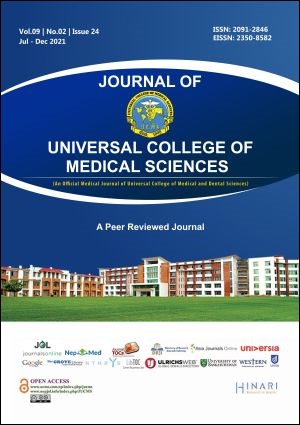Functional Outcome of Proximal Humerus Fracture Managed Surgically by Joshi's External Stabilizing System
DOI:
https://doi.org/10.3126/jucms.v9i02.41990Keywords:
Constant Murley score, JESS, Proximal humerus fractureAbstract
INTRODUCTION: The ideal management of proximal humerus fracture is still controversial despite various treatment options. Conservative treatment with slab is fraught with shoulder stiffness and malunion while surgical treatment with plates and nail is fraught with infection and blood loss. Therefore, Joshi External Stabilization System (JESS) being a minimally invasive percutaneous procedure can be the ideal treatment for these fractures.
MATERIAL AND METHODS: This prospective and observational hospital based study was carried out in Orthopedics Department, Universal College of Medical Sciences Teaching Hospital (UCMS-TH) from December 2018 to January 2021. All patients with traumatic proximal humerus fracture who fulfilled the inclusion criteria were enrolled in the study and were treated with JESS. Fracture was classified according to Neer classification and functional outcome was assessed according to Constant Murley Score (CMS) system. Post-operatively patients were regularly followed at 6 weeks, 3 months and 6 months.
RESULTS: There was statistically significant difference in VAS score (p<0.05) measured at six weeks, three months and six months; and CMS (p<0.05) at three months and six months. There was statistically significant difference between fracture type (Neer type) and fracture union (p<0.05). But the association between functional outcome and type of fracture was statically insignificant (p>0.05).
CONCLUSION: Displaced proximal humerus fracture when treated surgically with JESS has good functional and radiological outcome. It produces less pain, less stiffness and greater Range of Motion (ROM).
Downloads
Downloads
Published
How to Cite
Issue
Section
License
Copyright (c) 2021 Journal of Universal College of Medical Sciences

This work is licensed under a Creative Commons Attribution-NonCommercial 4.0 International License.
Authors have to give the following undertakings along with their article:
- I/we declare that this article is original and has not been submitted to another journal for publication.
- I/we declare that I/we surrender all the rights to the editor of the journal and if published will be the property of the journal and we will not publish it anywhere else, in full or part, without the permission of the Chief Editor.
- Institutional ethical and research committee clearance certificate from the institution where work/research was done, is required to be submitted.
- Articles in the Journal are Open Access articles published under the Creative Commons CC BY-NC License (https://creativecommons.org/licenses/by-nc/4.0/)
- This license permits use, distribution and reproduction in any medium, provided the original work is properly cited, and it is not used for commercial purposes.




